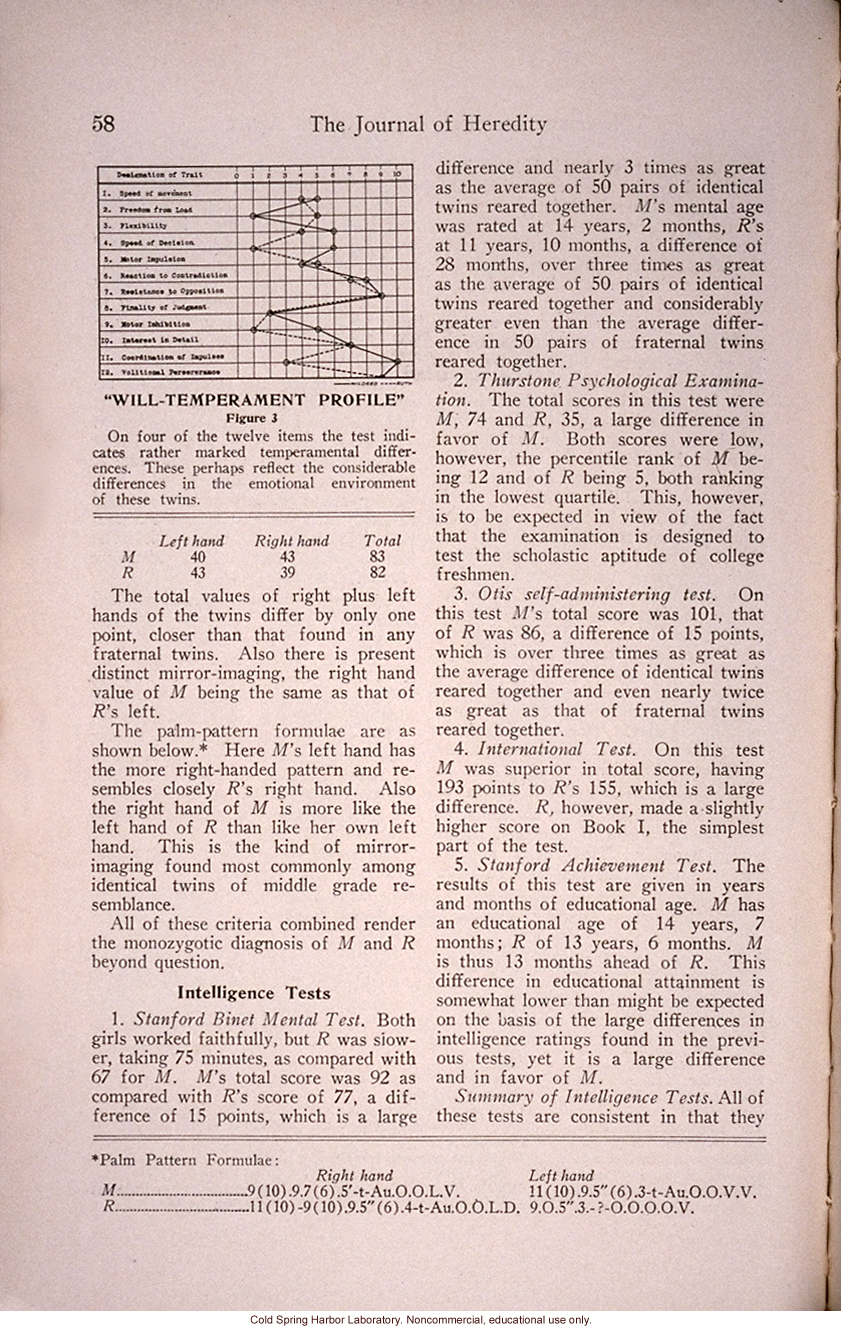58 The Journal of Heredity
[chart]
"Will-Temperament Profile"
Figure 3
On four of the twelve items the test indicates rather marked temperamental differences. These perhaps reflect the considerable differences in the emotional environment of these twins.
[double hairline score, column width]
Left Hand & Right Hand & Total
M & 40 & 43 & 83
R & 43 & 39 & 82
The total values of right plus left hands of the twins differ by only one point, closer than that found in any fraternal twins. Also there is present distinct mirror-imaging, the right hand value of M being the same as that of R's left.
The palm-pattern formulae are as shown below.* Here M's left hand has the more right-handed pattern and resembles closely R's right hand. Also the right hand of M is more like the left hand of R than like her own left hand. This is the kind of mirror-imaging found most commonly among identical twins of middle grade resemblance.
All of these criteria combined render the monozygotic diagnosis of M and R beyond question.
Intelligence Tests
1 Stanford Binet Mental Test. Both girls worked faithfully, but R was slower, taking 75 minutes, as compared with 67 for M. M's total score was 92 as compared with R's score of 77, a difference of 15 points, which is a large difference and nearly three times as great as the average of 50 pairs of identical twins reared together. M's mental age was rated at 14 years, 2 months, R's at 11 years, 10 months, a difference of 28 months, over three times as great as the average of 50 pairs of identical twins reared together and considerably greater even than the average difference in 50 pairs of fraternal twins reared together.
2. Thurstone Psychological Examination. The total scores in this test were M, 74 and R, 35, a large difference in favor of M. Both scores were low, however, the percentile rank of M being in the lowest quartile. This, however, is to be expected in view of the fact that the examination is designed to test the scholastic aptitude of college freshmen.
3. Otis self-administering test. On this test M's total score was 101, that of R was 86, a difference of 15 points, which is over three times as great as the average difference of identical twins reared together and even nearly twice as great as that of fraternal twins reared together.
4. International Test. On this test M was superior in total score, having 193 points to R's 155, which is a large difference. R, however, made a slightly higher score on Book I, the simplest part of the test.
5. Stanford Achievement Test. The results of this test are given in years and months of educational age. M has an educational age of 14 years, 7 months; R of 13 years, 6 months. M is thus 13 months ahead of R. This difference in educational attainment is somewhat lower than might be expected on the basis of large differences in intellectual ratings found in the previous tests, yet it is a large difference and in favor of M.
Summary of Intelligence Tests. All of these tests are consistent in that they
[double hairline score width of page]
*Palm Pattern Formulae:
& & Right hand & Left hand
M . . . & 9 (10) .9.7 (6) .5`-t-Au.O.O.L.V. & 11 (10) .9.5" (6) .3-t-Au.O.O.V.V.
R . . . & 11 (10) -9 (10).9.5" (6) .4-t-Au.O.O.L.D. & 9.O.5".3.-?-O.O.O.O.V.
[end]


